
The Order of the Yellow Ribbon was founded in 1600 in Nevers by French-Italian nobleman Charles III, Duke of Nevers, nephew of the French king Henry III, and knights would be imposed very peculiar tasks.

The Order of the Yellow Ribbon was founded in 1600 in Nevers by French-Italian nobleman Charles III, Duke of Nevers, nephew of the French king Henry III, and knights would be imposed very peculiar tasks.
They would have to practice the Italian game "la mara" (raising even or odd numbers of fingers), ride on a gray horse with a red-dyed bridle, and share their goods. Ackermann writes that, according to some sources, partner exchange would also be part of the obligations of membership.
The French king forbade the Order soon after its founding. This remarkable chivalric Order, one that could be perceived as a mockery of existing chivalric orders, is nevertheless included in the historical orders of France.
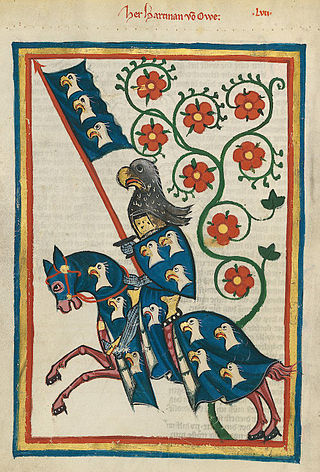
A knight is a person granted an honorary title of knighthood by a head of state or representative for service to the monarch, the church or the country, especially in a military capacity. Knighthood finds origins in the ancient Greek hippeis (ἱππεῖς) and Roman equites.
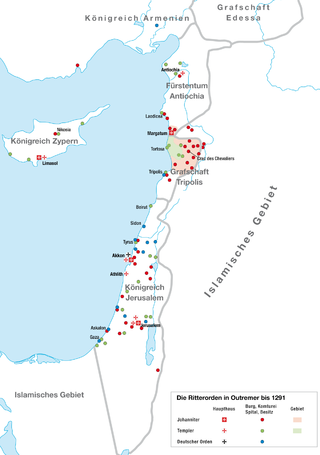
A military order is a Christian religious society of knights. The original military orders were the Knights Templar, the Knights Hospitaller, the Order of Saint James, the Order of Calatrava, and the Teutonic Knights. They arose in the Middle Ages in association with the Crusades, both in the Holy Land, the Baltics, and the Iberian peninsula; their members being dedicated to the protection of pilgrims and Christians, as well as the defence of the Crusader states. They are the predecessors of chivalric orders.

An order of chivalry, order of knighthood, chivalric order, or equestrian order is an order of knights, typically founded during or inspired by the original Catholic military orders of the Crusades and paired with medieval concepts of ideals of chivalry.

The Order of the Holy Spirit, is a French order of chivalry founded by Henry III of France in 1578. Today, it is a dynastic order under the House of France.
Commander, or Knight Commander, is a title of honor prevalent in chivalric orders and fraternal orders.

The Order of the Annunciation, not to be mistaken with Savoy and Italy's Supreme Order of the Most Holy Annunciation, was a chivalric order founded in 1619 by Charles Gonzaga, Duke of Mantua and Montferrat, Duke of Nevers and soon flourished.
The Noble Order of Saint George of Rougemont was a baronial order of chivalry established around 1440 in the Free County of Burgundy. From the 15th through the late 18th centuries it enjoyed the protection of the Dukes of Burgundy and later the French kings. It was abolished in the wake of the French Revolution and became extinct after the death of the last knight in 1869.
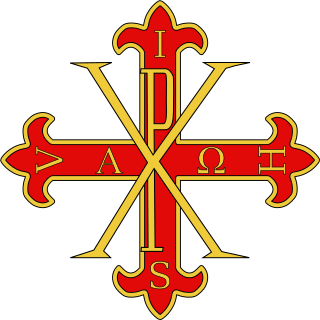
The Sacred Military Constantinian Order of Saint George, also historically referred to as the Imperial Constantinian Order of Saint George and the Order of the Constantinian Angelic Knights of Saint George, is a dynastic order of knighthood of the House of Bourbon-Two Sicilies. Currently, the grand magistry of the order is disputed among the two claimants to the headship of the formerly reigning House of Bourbon-Two Sicilies as heirs of the House of Farnese, namely Prince Pedro and Prince Carlo. The order was one of the rare orders confirmed as a religious-military order in the papal bull Militantis Ecclesiae in 1718, owing to a notable success in liberating Christians in the Peloponnese. Together with the Sovereign Military Order of Malta, it is one of a small number of Catholic orders that still have this status today. It is not an order of chivalry under the patronage of the Holy See, but its membership is restricted to practising Catholics.
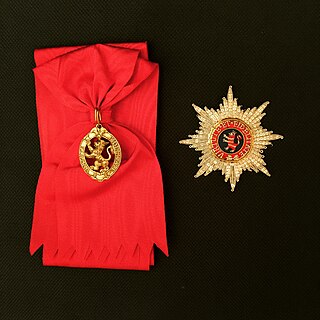
The House Order of the Golden Lion was an order of the German Landgraviate and Electorate of Hesse-Kassel and later, the Grand Duchy of Hesse and by Rhine. It was first instituted in 1770 by Landgrave Frederick II, in honour of and under the patronage of Saint Elizabeth of Hungary, an ancestor of the House of Hesse, and was intended to award auspicious merit.

The Ordre du Croissant was a chivalric order founded by Charles I of Naples and Sicily in 1268. It was revived in 1448 or 1464 by René I, king of Jerusalem, Sicily and Aragon, to provide him with a rival to the English Order of the Garter. René was one of the champions of the medieval system of chivalry and knighthood, and this new order was neo-Arthurian in character. Its insignia consisted of a golden crescent moon engraved in grey with the word LOZ, with a chain of 3 gold loops above the crescent. On René's death, the Order lapsed.
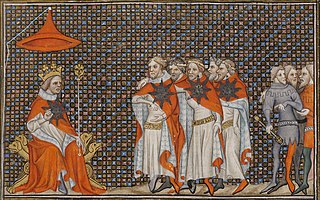
The Order of the Star or Company of the Star was an order of chivalry founded on 6 November 1351 by John II of France in imitation of the Order of the Garter founded in 1348 by Edward III of England. The inaugural ceremony of the order took place on 6 January 1352 at Saint-Ouen, from which it is sometimes called the Order of Knights of the Noble House of Saint Ouen.
The Order of the Ermine was a chivalric order of the 14th and 15th centuries in the Duchy of Brittany. The ermine is the emblem of Brittany. In the 20th century, it was revived by the Cultural Institute of Brittany as an honor for those contributing to Breton culture.
The Order of the Belt of Hope was a knighthood order which was founded in 1389 by King Charles VI of France and dedicated it to "Our Lady who bring back home the lost hunters".
The Order of the Passion of Christ was a French knighthood order which was founded in 1380 by King Richard II of England and in 1400 by his father-in-law king Charles VI of France. It was a crusader knighthood.
John I, Duke of Bourbon founded in 1414 the Order of the Golden Chains.
The 'Order of the Greyhound' was founded in 1416 in the Duchy of Bar. One also called this chivalric order, the "Order of the Faithfulness"
In 1369, Louis II "the Good", duke of Bourbon founded the Knights of the Golden Shield to commemorate the release from English captivity of noble hostages held along with the king John II of France. This release came in 1369, three years after the death of the captive king.
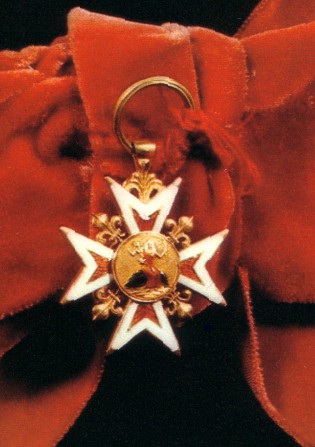
The Order of Our Lady of Mount Carmel was founded in 1608 by Pope Paul V at the request of King Henry IV of France.

The Order of the Broom-cod, is believed to have been founded in 1234 by the French king, St. Louis IX, to commemorate his wedding with Margaret of Provence, daughter of Ramon Berenguer IV, Count of Provence, and her coronation. Other sources mention Charles VI the Beloved as the founder.
The Order of the Ermine was a chivalric order created in 1464 by king Ferdinand I of Naples. The motto was "Malo mori quam foedari".